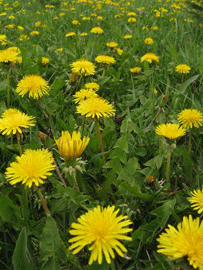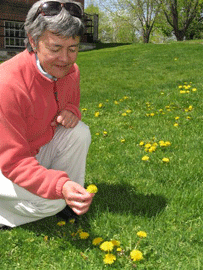Dandy Dandelions
Air Date: Week of July 24, 2009

(Photo: Laurie Sanders)
Dandelions are often dismissed as a lowly weed. But plant biologist Joan Edwards sees the flower as an amazing engineering marvel. Producer Laurie Sanders took to the lawns of Williams College with Edwards to find out more about the virtues of dandelions.
Transcript
YOUNG: Dandelions. For many lawn owners they’re simply the enemy. But the historic relationship between dandelions and humans is long and complex.
As far back as the 10th century, the plant was prized as both a medicine and a food. When European settlers came to America they brought dandelion seeds, helping the weed cross the Atlantic and land in your yard.
Producer Laurie Sanders visited with a biologist in Western Massachusetts who’s found new affection for this much-maligned flower.
[SOUND OF WALKING]
SANDERS: If you’re a plant biologist, one of the nice things about studying dandelions is that you don’t need a very big budget to cover travel expenses. In Joan Edwards’ case, all she needs to do is step outside the science building at Williams College.
EDWARDS: Right along here, they’ve escaped the mower there. But we’ll go around just a little further, because I think they’re out on the lawn as well as next to the building.
SANDERS: Looping around, just as she predicted, we find a patch of lawn covered in dandelions.
EDWARDS: Let’s pick one so we can look at the flower closely, [snap] and then maybe we’ll look at a developing seed head too. [snap].

(Photo: Laurie Sanders)
EDWARDS: There’s just this most amazing thing that happens. The entire flower head, instead of being straight up, bends down to the ground, and becomes almost flat to the ground so the developing seed is actually sitting down next to the ground. And when the seeds are ready to be dispersed, that entire stalk that’s holding now the seed head, straightens and then elongates sometimes as much as twelve inches in a matter of a day or two. It’s remarkable.
SANDERS: Which is why you can mow your lawn on one day, and then the next day discover dandelion stalks -- covered with seeds -- sticking up all over your yard.
Edwards says this dance of the stem is just one of many interesting aspects of dandelion biology. Here’s another. A dandelion isn’t a single flower, but is actually composed hundreds of tiny flowers. Edwards and her students have teased the flower-heads apart and counted up to 250 flowers on a single dandelion. Each day a few flowers on the dandelion mature, with the ones on the edges blooming first and those in the center last.
But even more interesting, is that the reproductive parts of the flowers—the stamens and pistils-- are concentrated in the center of the dandelion. We can see this if we take a close look, but for a bee or other insect pollinator, those differences are obvious from a long way off. That’s because the petals that we see around the edges and the reproductive parts in the middle absorb light in the ultraviolet portion of the spectrum differently. Edwards says the reproductive parts absorb UV, but the petals on the edges don’t.

Joan Edwards sees the dandelion as much more than a weed. (Photo: Laurie Sanders)
SANDERS: A single dandelion usually takes three to four days to bloom. Within that time, insects usually visit the flowers, gathering nectar or pollen. In the process, the insect often transfers pollen from one dandelion plant to another, which promotes cross-pollination. But, Edwards says, like some other species of plants, dandelions have another way of producing seeds. A kind of evolutionary fall-back position.
EDWARDS: They don’t require cross-pollination in order to set seed. They’re what we call apomictic. So apomixis is when you can just set seed in the absence of any pollination at all. So it’s a way of selfing. So sometimes the seeds that are produced in a seed-head are really just clones of the parent plant. So that’s another very successful trait. If you happen to be an isolated dandelion and you don’t have a neighbor nearby to breed with, you just self and create seeds and there you are.
SANDERS: Once the seeds are produced, they’ll disperse over a day or two--their feathery parachutes carrying them high into the air. If all goes well for the dandelion, the seeds will land in a spot that’s suitable for germination. And in spite of what you might think, dandelions don’t grow just anywhere. They’re common in lawns and fields for a very specific reason.
EDWARDS: Dandelions are potassium hogs. They love potassium. And a lot of people use potassium fertilizer in their lawn. It’s just part of a general fertilizer mix that you would throw on your lawn.

(Photo: Laurie Sanders)
EDWARDS: And he always gets questions about what to do if people get ants in their kitchen. And he said, do you know what I tell them? I tell them to bend over and look at them carefully. And I think the same could be said for dandelions. If you bend over and look at them carefully, you’ll see just this amazing botanical, engineering marvel.
SANDERS: Although the peak of dandelion season is late spring, dandelions have been known to bloom all year long. So lawn owners still have time to get up close and personal with this common, but extraordinary flower. For Living on Earth, I’m Laurie Sanders.
[MUSIC: Chris Murphy “Dandelion rag” from Juniper (Kufala records 2005]
Links
Dandelions Through the UV filter
Biologist Joan Edwards, Williams College
Dandelions in the Kitchen: A quick and easy dandelion recipe.
To hear more stories by naturalist Laurie Sanders on WFCR, click here.
Living on Earth wants to hear from you!
Living on Earth
62 Calef Highway, Suite 212
Lee, NH 03861
Telephone: 617-287-4121
E-mail: comments@loe.org
Newsletter [Click here]
Donate to Living on Earth!
Living on Earth is an independent media program and relies entirely on contributions from listeners and institutions supporting public service. Please donate now to preserve an independent environmental voice.
NewsletterLiving on Earth offers a weekly delivery of the show's rundown to your mailbox. Sign up for our newsletter today!
 Sailors For The Sea: Be the change you want to sea.
Sailors For The Sea: Be the change you want to sea.
 The Grantham Foundation for the Protection of the Environment: Committed to protecting and improving the health of the global environment.
The Grantham Foundation for the Protection of the Environment: Committed to protecting and improving the health of the global environment.
 Contribute to Living on Earth and receive, as our gift to you, an archival print of one of Mark Seth Lender's extraordinary wildlife photographs. Follow the link to see Mark's current collection of photographs.
Contribute to Living on Earth and receive, as our gift to you, an archival print of one of Mark Seth Lender's extraordinary wildlife photographs. Follow the link to see Mark's current collection of photographs.
 Buy a signed copy of Mark Seth Lender's book Smeagull the Seagull & support Living on Earth
Buy a signed copy of Mark Seth Lender's book Smeagull the Seagull & support Living on Earth

